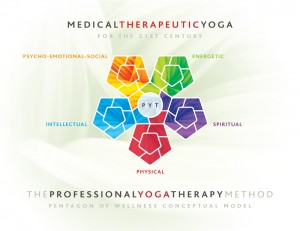
Yoga as Medicine II (Module 14): Emerald Isle, NC
2016-Oct-Sat @ 8:00 am - 2016-Oct-Sat @ 5:00 pm
 Yoga as Medicine II (Module 14): Emerald Isle, NC
Yoga as Medicine II (Module 14): Emerald Isle, NC
Description
Module 14 is the second of three on-site intensives which allows students to assimilate and apply objectives from Modules 1-7, 8, and 10. Module 14, through the following objectives, allows clinicians to learn new modifications of the yoga postures, breathing techniques, and sequencing. Teaching methodology, sequencing, evaluation and case study practicums, and functional practice of medical yoga therapy as it applies to the musculoskeletal and gastrointestinal systems is included at this level. In addition, the biomechanics of spinal motion are studied as they relate to therapeutic practice and prescription, including 30 new yoga postures and progressive techniques in breathing and meditation.
Topics covered include:
Orthopaedic series (10 pathophysiologies)
Gastrointestinal series (9 pathophysiologies)
Yoga posture, breath, and meditation prescription in integrative medicine
CCEUs: 38.00
Clinical Objectives
- Practice 30 new postures, breathing techniques, and their modifications in the PYT method to your therapeutic yoga toolbox.
- Discuss contraindications and precautions for 30 new postures and related modifications and sequences.
- Identify evidence of imbalance in order to list a minimum of three interventions for each of the five facets of the pentagon of wellness model in order to affect positive change in orthopaedic health and gastrointestinal function.
- Utilizing your knowledge of abdominal cavity anatomy, physiology, and through a review of the historical context and epidemiology of gastrointestinal dysfunction, experience 9 sequences for gastrointestinal functional dysfunction in order to understand the orthopaedic connection through hands on lab work.
- Practice 10 sequences for orthopaedic disorders and preventive health through hands on experiential lab work:
- Evaluating the Athlete
- The Shoulder Complex
- ACL Injuries
- Spine – Mobility in Flexion and Rotation
- Plantar Fasciitis and Foot Deformities
- Osteoarthritis of Spine, Knee, Hip, Hands, Feet
- The Achilles Tendon
- Iliotibial Band and Patello-femoral Syndrome
- The Hip
- Design and present preventive and pathophysiologically based medical therapeutic yoga programs in a multi-disciplinary team approach for orthopaedic and gastrointestinal patient populations over the course of 6 case study exercises in order to critically analyze their effectiveness and safety.
- Describe the effects of neuroendocrine in order to understand interventions using medical therapeutic yoga.
- Explain how learning style models affect prescription of intervention and management in medical therapeutic yoga.
- Explain how application of non-dogmatic yogic philosophy and the yogic seal can facilitate universal positive growth in personal and professional development.
- Recognize the historical and medical importance of differential diagnosis in practicing medical therapeutic yoga.
- Experience how positional changes of the stomach and internal anatomy can affect yoga posture performance and prescription in the PYT method.
- List differential diagnosis concerns in the practice of medical therapeutic yoga.
- Demonstrate proficiency at teaching sequences in your clinical area of expertise through utilization of both east and west medical terminology for synthesis of a new functional medical therapeutic yoga language to create a healthy dialogue with east/west practitioners.
- Experience meditation practices to develop critical skills in prescribing effective and safe restorative mind-body practices.
- Demonstrate the effects of biomechanical laws and how yoga postures are evolved by them.
- Experience how evidence based biomechanical and kinematic study of spinal flexion and rotation evolve the practice of yoga and change traditional approaches to yoga posture alignment in order to improve safety and clinical efficacy.
- Experience how lower quarter alignment and motor control execution in yoga posture prescription affect overall mind-body outcomes.
- Course Includes
Tuition includes a digital course manual. Lodging is extra and includes three meals a day.
The digital course manual contains excerpts from the Professional Yoga Therapy Volume III E-Book which provides approximately 200 photographs, illustrations, graphs, and tables for GI and MS prescription. Topics include Arthrokinematics & Biomechanical Analysis of Spinal Flexion & Rotation Posture Prescription, Gastrointestinal Sequence Prescription to include 10 diagnoses/prevention programs, and Musculoskeletal Sequence Prescription to include 9 Joint diagnoses/prevention programs. The manual is the third level and progression companion to PYT Volumes I and II and corresponds to the 12-part distance learning Module 10 series.
*Lodging is extra and includes three meals a day and linen package.
PYT is an NATA approved provider and NC PT Approved Provider.
DETAILS & TO REGISTER HERE
**Course taught by Ginger Garner, Founder/Director of PYTI. Teaching Assistant: Shelly Prosko, PT, PYT, CPI
